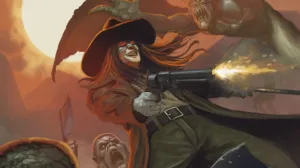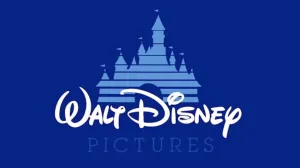This week’s episode of Star Trek: Strange New Worlds, “Subspace Rhapsody,” boldly went where no Star Trek episode has gone before. It’s Star Trek’s first musical episode, which sees an experiment with subspace communications creating a growing anomaly that traps those within its reach in a universe of musical theater logic. The entire crew of the USS Enterprise gets caught up in it and as a result, relationships came under stress, and more than one heart is broken by the time the music stops. Even the Klingons get in on the musical festivities, both as a threat and as participants.
Videos by ComicBook.com
Star Trek; Strange New Worlds turned to Dermott Downs, a veteran of The CW’s Arrowverse, to direct the episode. Speaking to ComicBook.com, he talks about filming the episode and the Sound of Music moment they imagined but ultimately left out of the episode. Here’s what they told us:
Jamie Lovett, ComicBook.com: How did you end up directing this musical episode? Did you volunteer, or did they pitch the idea to you?
Dermott Downs: I was a big fan of the original [Star Trek], but I had never been part of Discovery, Picard, or any of these newer iterations. I had a meeting with Secret Hideout, and they were talking about new things they were doing, things that were in production. Season 1 [of Star Trek: Strange New Worlds] hadn’t dropped yet, but they were deep into Season 2 already, and they said, “We have a sitcom, three-camera comedy episode, and we have a musical.” I was like, “Well, hey, I memorized the songbook to Oliver Twist at seven. I did a big Flash/Supergirl episode. I did probably multiple years of music videos under my belt. Let me pitch.”
But it sort of sounded like, “God, you could be jumping the shark.” How do you take an outer space show going beyond the limits of our galaxy and then turn it into a musical? But they hit the right notes. They still kept it grounded and music became a virus that infects the ship that gives exposition to things they can’t normally talk about. So it still stayed grounded, and the songs just ranged from melancholic solos to a crazy duet with Anson and Batel to Nurse Chapel’s celebration of freedom in the mess hall, Celia’s was such a power ballad, Spock’s sad, introspective reflection of who he is and seeing his relationship with Chapel not being what he would hope. You give that to songwriters, and I was fortunate to be blessed with the great cast and crew and a wonderful choreographer to really flesh that out.
What were some of the stylistic goals going into the episode? I noticed some of the numbers had more of a music video vibe than a stage musical vibe, like La’an’s song that cuts to her in bed with Kirk.
The rest of the narratives take place within the place of work or the privacy of quarters like Chrissy’s song, or certainly, Celia and Ethan are left alone, and those songs are really to themselves about their past and their longings. Anson’s is a humiliating duet in front of everybody. Chrissy’s — she basically is witness to the end of Paul and Rebecca’s song in the hallway. She’s understanding what’s happening, and it starts to hit her right as she’s in the hallway outside her room, so she gets herself in her room, and it’s a real introspective, self-examining song about how she can’t express this love she has. Originally, that breakout moment, we were talking about doing something like The Sound of Music, but it just became too huge and out of step with the episode and it would’ve been fun to go completely opposite of outer space.
We were talking about her history with Kirk, and they were doing pickups with Amanda who directed that episode where they were on an alternate Earth, and they were in the city, and they were at that hotel. So then it became, “Okay, well what if that interior moment is just a really intimate handheld imagining of love?” I know it probably has a music video feel, but I was going for something much more like Terrence Malick and emotional. It has that visual language that we’re familiar with in music videos, but I felt it served the story better than, “The hills are alive with the sound of music,” even though that would’ve been really, really, really fun. We really tried to let each song drive it, and there’s no real choreography in that. She comes into the room, and it’s more getting her to the window, to the bed, and in bed, and then back up as she realized she’s got to go to the bridge and share what’s happening.
Some of these actors have plenty of experience in musical theater, and others don’t. Did any of the cast need a little warming up to this while you were working with them? Or were they all pretty eager right out of the gate?
Yeah, they were. They were all really on board. I mean, they were coming in and rehearsing on the weekends. After work during the week, they would go to the sound studio to record their versions because we were working off like temp tracks when I came in. Ethan, Anson, and Paul, I mean, they probably were the ones that said, “Look, I’ve never done a musical …” but each of their songs, I mean, Ethan did such a great job with Spock because it’s him longing for this human vulnerability, yet he’s still got that Vulcan mindset. There’s a lot of nuance to that, and in spite of this being musical, you’re moving big storylines forward.
Anson’s is a kind of country duet that goes sideways in front of the whole crew. That was the one I was probably every day going, “Oh my God, I can’t wait to see that and be on the set with that,” because it was great. He’s horrified that he’s expressing this in front of everybody, and yet he’s getting down on his knee to profess love. Each one was so different.
Were there any numbers that proved particularly challenging or daunting? From watching the episode, I’d that Jess Bush’s number was the toughest since it involved the most choreography.
Yeah, I would say the biggest challenge was Nurse Chapel’s in the mess hall, because of this sheer, full-blown choreography that that entailed. She gets the whole mess hall to join her, and the only person not dancing is Spock, who’s kind of watching everything he’s hoped or dreamed might happen with him with her go down the tubes. She’s got to fall into the arms. She’s got to be crowd surfed. She’s got to move through dancers that she interacts with, and yet it starts with her telling him, “This is how it is,” and then it moves into it. There were so many elements and interactive elements to that, that that probably had the most full-blown rehearsals, just so everybody would be prepared on the day and you’re not trusting someone’s going to catch you, and on the day they don’t.
But the last number, the big finale, was shot in so many different pieces because it’s all over the ship and coming together. I knew that was going to be very exciting because in focusing on these elements and knowing how you’re going to transition, there’s not a lot of shots here, but okay, this is the whole crew running down the hallway and the camera’s going to rotate. There’s no other shot here. We’re going to spin this, Chapel and Babs, and find them. I knew that was going to have its fun interactive intercutting that was going to build to the Klingons in a battle of the bands.
That Klingon hip-hop interlude was something. Was that on the page, or was that developed as you were working on it, like the cut to the hotel in the Christina Chong number?
It started there, and then there was concern that maybe we had gone a bridge too far. We did more of a song number where they didn’t dance and we shot that, but everybody was like, “What?” Look, okay, if somebody’s worried, there is a version, but it’s nowhere going to help us propel to this final conquering of the anomaly, especially if they’re mortified that they’ve been compelled to sing. You want it to be something outrageous, it was great. It would’ve been funner if that was a bigger number and we could have been on the ship with them as opposed to just a screenshot but it was great. So that re-evolved to what it was, and it stayed where it was.
Did any of the songs end up getting stuck in your head? Were you humming any particular number after you left the set?
We ended on Chapel’s big number, and that became the wrap to the episode, and everybody started singing that acapella, and then even the background actors were joining in. People hung out for an hour. It was the end of the episode, it was the last song, but the cast and crew hung out for other people’s songs. They were so into, “Oh, what are you doing?” But “Private Conversations” was crazy, and it becomes this relationship exposed like that one, but they were also individual. Celia’s power ballad, it’s hard to not have that go through your head. I would say there weren’t any real favorites because I thought everybody did such a great job, and I had fun trying to visualize them cinematically but still keep them grounded in how the story was moving. Music was moving their story forward.
How to watch Star Trek: Strange New Worlds Season 2
Star Trek: Strange New Worlds Season 2 debuts new episodes on Thursdays on Paramount+ in the United States, the U.K., Australia, Latin America, Brazil, France, Italy, Germany, Switzerland, and Austria. The second season will stream on Paramount+ in South Korea, with a premiere date still to be announced.
Star Trek: Strange New Worlds Season 1 is also streaming on Paramount+. It is also available as home media on Blu-ray, DVD, and 4k UHD.








